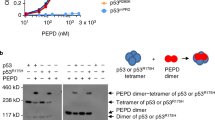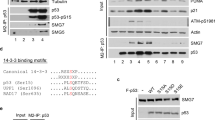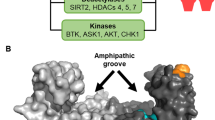Abstract
The small basic protein p14ARF, encoded by one of the alternative transcripts from the human INK4A/ARF locus, interferes with MDM2-mediated ubiquitination of the p53 tumour suppressor protein. The resultant stabilization of p53 leads to increased expression of p53-regulated genes, such as MDM2 itself and the cyclin-dependent kinase inhibitor p21CIP1. Here we relate physical interactions between p14ARF and MDM2, as determined using synthetic peptides and systematic deletions of p14ARF, with consequential effects on p53 stabilization and transcriptional activity. The data imply that the amino terminal half of p14ARF, encoded by the alternative first exon (exon 1β) contacts MDM2 through multiple domains that can independently impede MDM2-mediated degradation of p53, provided that they are localized in the cell nucleus. As well as identifying previously unrecognized functional domains, our findings offer an explanation for the relative paucity of missense mutations in exon 1β in human tumours.
This is a preview of subscription content, access via your institution
Access options
Subscribe to this journal
Receive 50 print issues and online access
$259.00 per year
only $5.18 per issue
Buy this article
- Purchase on Springer Link
- Instant access to full article PDF
Prices may be subject to local taxes which are calculated during checkout








Similar content being viewed by others
References
Ashcroft M, Vousden KH . 1999 Oncogene 18: 7637–7643
Bates S, Parry D, Bonetta L, Vousden K, Dickson C, Peters G . 1994 Oncogene 9: 1633–1640
Bothner B, Lewis WS, DiGiammarino EL, Weber JD, Bothner SJ, Kriwacki RW . 2001 J. Mol. Biol. 314: 263–277
Burri N, Shaw P, Bouzourene H, Sordat I, Sordat B, Gillet M, Schorderet D, Bosman FT, Chaubert P . 2001 Lab. Invest. 81: 217–229
DiGiammarino EL, Filippov I, Weber JD, Bothner B, Kriwacki RW . 2001 Biochemistry 40: 2379–2386
El-Deiry WS, Tokino T, Velculescu VE, Levy DB, Parsons R, Trent JM, Lin D, Mercer WE, Kinzler KW, Vogelstein B . 1993 Cell 75: 817–825
Evan G, Littlewood T . 1998 Science 281: 1317–1322
Eymin B, Karayan L, Séité P, Brambilla C, Brambilla E, Larsen C-J, Gazzéri S . 2001 Oncogene 20: 1033–1041
Giaccia AJ, Kastan MB . 1998 Genes Dev. 12: 2973–2983
Haupt Y, Maya R, Kazaz A, Oren M . 1997 Nature 387: 296–299
Hollstein M, Rice K, Greenblatt MS, Soussi T, Fuchs R, Sørlie T, Hovig E, Smith-Sørensen B, Montesano R, Harris CC . 1994 Nucl. Acids Res. 22: 3551–3555
Honda R, Yasuda H . 1999 EMBO J. 18: 22–27
Kamijo T, Weber JD, Zambetti G, Zindy F, Roussel MF, Sherr CJ . 1998 Proc. Natl. Acad. Sci. USA 95: 8292–8297
Kubbutat MHG, Jones SN, Vousden KH . 1997 Nature 287: 299–303
Levine AJ . 1997 Cell 88: 323–331
Lindström MS, Klangby U, Inoue R, Pisa P, Wiman KG, Asker CE . 2000 Exp. Cell Res. 256: 400–410
Llanos S, Clark PA, Rowe J, Peters G . 2001 Nature Cell Biol. 3: 445–452
Lohrum MAE, Ashcroft M, Kubbutat MHG, Vousden KH . 2000 Curr. Biol. 10: 539–542
Midgley CA, Desterro JMP, Saville MK, Howard S, Sparks A, Hay RT, Lane DP . 2000 Oncogene 19: 2312–2323
Miyashita T, Reed JC . 1995 Cell 80: 293–299
Momand J, Jung D, Wilczynski S, Niland J . 1998 Nucl. Acids Res. 26: 3453–3459
Pomerantz J, Schreiber-Agus N, Liégeois NJ, Silverman A, Alland L, Chin L, Potes J, Chen K, Orlow I, Lee H-W, Cordon-Cardo C, DePinho RA . 1998 Cell 92: 713–723
Quelle DE, Cheng M, Ashmun RA, Sherr CJ . 1997 Proc. Natl. Acad. Sci. USA 94: 669–673
Rizos H, Darmanian AP, Mann GJ, Kefford RF . 2000 Oncogene 19: 2978–2985
Rizos H, Puig S, Badenas C, Malvehy J, Darmanian AP, Jiménez L, Milà M, Kefford RF . 2001 Oncogene 20: 5543–5547
Ruas M, Peters G . 1998 Biochim. Biophys. Acta 1378: 115–177
Sharpless NE, DePinho RA . 1999 Curr. Opin. Genet. Dev. 9: 22–30
Sherr CJ . 1998 Genes Dev. 12: 2984–2991
Soussi T, Dehouche K, Béroud C . 2000 Hum. Mutat. 15: 105–113
Stott FJ, Bates S, James MC, McConnell BB, Starborg M, Brookes S, Palmero I, Hara E, Vousden KH, Peters G . 1998 EMBO J. 17: 5001–5014
Vogelstein B, Lane D, Levine AJ . 2000 Nature 408: 307–310
Weber JD, Kuo M-L, Bothner B, DiGiammarino EL, Kriwacki RW, Roussel MF, Sherr CJ . 2000 Mol. Cell. Biol. 20: 2517–2528
Weber JD, Taylor LJ, Roussel MF, Sherr CJ, Bar-Sagi D . 1999 Nature Cell Biol. 1: 20–26
Xirodimas D, Saville MK, Edling C, Lane DP, Lain S . 2001 Oncogene 20: 4972–4983
Zhang Y, Xiong Y . 1999 Molec. Cell 3: 579–591
Zhang Y, Xiong Y, Yarbrough WG . 1998 Cell 92: 725–734
Acknowledgements
We are grateful to S Drayton for helping with some of the experiments, to D Parry for the DP54-75 antiserum, to D Joshi and N O'Reilly for peptide synthesis, and to P Parker and N McDonald for comments on the manuscript.
Author information
Authors and Affiliations
Corresponding author
Rights and permissions
About this article
Cite this article
Clark, P., Llanos, S. & Peters, G. Multiple interacting domains contribute to p14ARF mediated inhibition of MDM2. Oncogene 21, 4498–4507 (2002). https://doi.org/10.1038/sj.onc.1205558
Received:
Revised:
Accepted:
Published:
Issue Date:
DOI: https://doi.org/10.1038/sj.onc.1205558
Keywords
This article is cited by
-
Time varying causal network reconstruction of a mouse cell cycle
BMC Bioinformatics (2019)
-
A redox mechanism underlying nucleolar stress sensing by nucleophosmin
Nature Communications (2016)
-
Apoptosis induced by 1,3,6,7-tetrahydroxyxanthone in Hepatocellular carcinoma and proteomic analysis
Apoptosis (2012)
-
Binding to nucleophosmin determines the localization of human and chicken ARF but not its impact on p53
Oncogene (2008)
-
Stability of nucleolar versus non-nucleolar forms of human p14ARF
Oncogene (2004)



